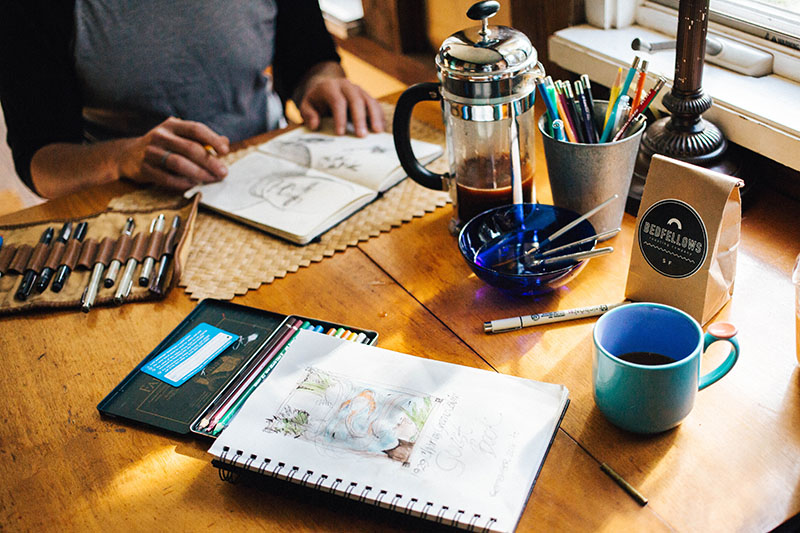Keep your eyes open. Listen. Follow your curiosity. Ideas are constantly trying to get your attention. Let them know you’re available.
Elizabeth Gilbert
Do you consider yourself a creative person?
You should.
Because creativity, as it turns out, is one of the simplest and most powerful assets we have when it comes to our emotional wellness.
Unfortunately, we often let our insecurities get in the way of exploring our creative instincts.
So, you’re not a professional painter or composer… not many of us are!
If you’re alive and willing to spend a little time creating, then you are a creative person.
Read on for 3 reasons creativity is good news for your emotional wellness:
1. Creativity engages your mind in healthy ways.
Possessing a creative mind is like having a border collie for a pet; if you don’t give it a job to do, it will find a job to do—and you might not like the job it invents.
Elizabeth Gilbert
Even when you’re unaware of it, your imagination is at work.
Spinning its wheels, churning away…
Trying to make sense of your past.
Writing fiction (or creative non-fiction) about the present.
And predicting the next hour (or week, or decade…) of your future.
Sometimes it happens quietly in the background.
But, other times, you’re painfully aware of it.
Maybe it shows up as the worries you can’t seem to shake. Or the regret that keeps replaying itself like a video clip in your mind.
Your mind is a powerful force that can be used for incredible good—or it can create stories that keep you feeling frightened, ashamed, or stuck.
The trick is to harness your creativity in ways that promote your emotional wellness.
Try this:
- Notice the stories you’re telling yourself. When you’re feeling tired, angry, lonely, or afraid, your imagination is likely working overtime to create a narrative around that feeling. Is that narrative helpful to your emotional wellness? Does it promote positive coping or growth?
- Create a new story. Let’s say you’re feeling lonely. If the story you’ve been telling yourself isn’t helpful (e.g., “You’re unpopular, and you always will be…”), why not use your creativity to write a new one? Think about your future and what new experiences you’d like to have. What will have to happen today, tomorrow, and the next day to lead you toward that conclusion? Write it down and then read it aloud to yourself. Keep it somewhere nearby where you can re-read it often.
2. Creativity promotes identity development.
In every work of art, the artist himself is present.
Christian Morgenstern
Still figuring out who you are and what you’re all about?
You’re in good company… it means you’re human!
But if all that soul-searching is getting a bit draining, fortunately there’s a more playful alternative:
Just get started creating something.
It could be a anything…
a sculpture,
a poem,
a recipe,
a piece of furniture,
a new dance move,
a guitar riff,
an outfit or makeup look,
a Lego creation…
…it just has to be made by you.
Try not to take it too seriously and enjoy the process.
You might be surprised by what you learn about yourself.
Try this:
- Put together a creativity kit or space in your home. It doesn’t have to be elaborate or pricey. Just assemble some basic materials you can use creatively, and designate a spot where you can use them.
- Make time to be creative. The next time you sit down to consume something (e.g., TV, social media posts, news) why not try creating something instead?
- Reflect. Each time your create something, ask yourself: What does this say about me? How does it make me feel? What does it inspire me to think, feel, or do?
- Share your creations with others. Check your ego at the door and show your partner, child, roommate, or buddy what you’ve made. Ask them what they’re working on or—better yet—invite them to join you next time.
3. Creativity encourages problem-solving ability.
We can’t solve problems by using the same kind of thinking we used when we created them.
Albert Einstein
When it comes to facing life’s challenges, we often get stuck in ruts.
Using the same, familiar strategies over and over again.
But, not all problems require the same solution.
This is where creativity can be a real asset.
Try this: Think about a problem you’re facing at home, at work, or somewhere else. Complete the following sentences:
- When I think about this, I feel _____________, ______________, and generally stuck.
- I’m fairly sure that _______________, _________________, and ______________ are the main things that led to this problem.
- In trying to find a solution, I’ve tried ____________________, but that hasn’t worked because ___________________________.
- This isn’t the first time I’ve tried to solve a problem this way. In fact, I tend to rely on ___________ and ___________ when I’m facing a challenge.
- If my go-to strategies were no longer an option, I would probably try ___________________ or ________________.
- And if all my instincts turned out to be wrong, and I had to try the complete opposite, I’d try________________, _________________, or _____________________.
- Now that I think about it, I’ve used a counterintuitive approach before, like that time when __________________, and it actually worked out pretty well. If I were to try that approach this time, I’d start by ______________________________…
Enjoy this post? You might also like:
Laughter: It’s Not Medicine, But It Sure Can Heal
How to Practice Gratitude When You’re Not Feeling Particularly Grateful
3 Myths About Emotional Wellness
Ready to learn how creativity can boost your emotional wellness?

